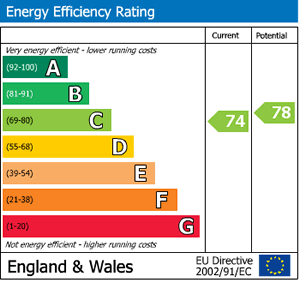Energy Performance Certificates
Energy Performance Certificates (EPCs) give information on how to make your home more energy efficient and reduce carbon dioxide emissions. All homes bought, sold or rented require an EPC.
The landlord must commission an EPC and ensure a copy of it, including the recommendation report, is available free of charge to prospective tenants at the earliest opportunity. As a minimum, this should be when prospective tenants are first given written information about a dwelling or are arranging to view it, and before any rental contract is entered into. A copy of the EPC (rating and recommendation report) must be given free of charge to the person who ultimately becomes the tenant before any rental contract is entered into.
From 1 October 2008, an EPC will be required whenever a building in the social or private rented sectors is let to a new tenant. A building can be: the whole of a building; or part of a building where the part is designed or altered to be used separately.
An EPC is only required for a dwelling that is self-contained, meaning that it does not share essential facilities such as a bathroom/shower room, wc or kitchen with any other dwelling, and that it has its own entrance, either from outside or through common parts, that is not through another unit. In instances of lettings where marketing activity is initiated pre-October 2008, an EPC is only required if the property continues to be offered for let on or after 1 October 2008.
Where the landlord has an agent, they may be given the task of ensuring that these requirements are met. However, the landlord will remain responsible for any breaches.
Example of energy efficiency rating graph for homes

Energy Performance Certificates - what they tell you
EPCs contain:
- information on your home's energy use and carbon dioxide emissions
- a recommendation report with suggestions to reduce energy use and carbon dioxide emissions
Energy use and carbon dioxide emissions
EPCs carry ratings that compare the current energy efficiency and carbon dioxide emissions with potential figures that your home could achieve. Potential figures are calculated by estimating what the energy efficiency and carbon dioxide emissions would be if energy saving measures were put in place.
The rating measures the energy and carbon emission efficiency of your home using a grade from 'A' to 'G'. An 'A' rating is the most efficient, while 'G' is the least efficient. The average efficiency grade to date is 'D'. All homes are measured using the same calculations, so you can compare the energy efficiency of different properties.
Around 27 per cent of the UK's carbon dioxide emissions come from domestic homes. Carbon dioxide contributes to climate change. Find out more by reading 'Climate change: a quick guide'.
The recommendation report
EPCs also provide a detailed recommendation report showing what you could do to help reduce the amount of energy you use and your carbon dioxide emissions. The report lists:
- suggested improvements, like fitting loft insulation
- possible cost savings per year, if the improvements are made
- how the recommendations would change the energy and carbon emission rating of the property
You don't have to act on the recommendations in the recommendation report. However, if you decide to do so, it could make your property more attractive for sale or rent by making it more energy efficient.
For more information on saving energy and whether you are eligible for energy efficiency grants to make your home more energy efficient, follow the link below.
The certificate also contains:
- detailed estimates of potential energy use, carbon dioxide emissions and fuel costs
- details of the person who carried out the EPC assessment
- who to contact if you want to make a complaint
What an EPC looks like
Information about energy efficiency and carbon emissions is summarised in two charts that show the energy and carbon dioxide emission ratings. The charts look similar to those supplied on electrical appliances, like fridges and washing machines. To see an example of an Energy Performance Certificate, use the link below.
How to get an EPC
You should receive an EPC when you are thinking about buying or renting a home. You'll need to provide one if you are selling or letting your home. If you need to obtain an EPC for your property please ask us we will be happy to help
Which buildings need an EPC?
An EPC is required when a building is constructed, rented or sold. A building will need an EPC if it has a roof and walls and uses energy to 'condition an indoor climate'. This means it has heating, air conditioning or mechanical ventilation. For example, a garden shed would not need an EPC if it doesn't have any heating.
The building can either be a whole building or part of a building that has been designed or altered to be used separately. If a building is made up of separate units, each with its own heating system, each unit will need an EPC.
For more details of when and which types of buildings require an EPC, read 'Improving the energy efficiency of our building'’ on the Communities and Local Government website.
Which buildings don't need an EPC?
The following buildings don't need an EPC when they are built, rented or sold:
- places of worship
- temporary buildings that will be used for less than two years
- standalone buildings with total useful floor area of less than 50 metres squared that aren't used to provide living accommodation for a single household
- industrial sites, workshops and non-residential agricultural buildings that don't use a lot of energy







